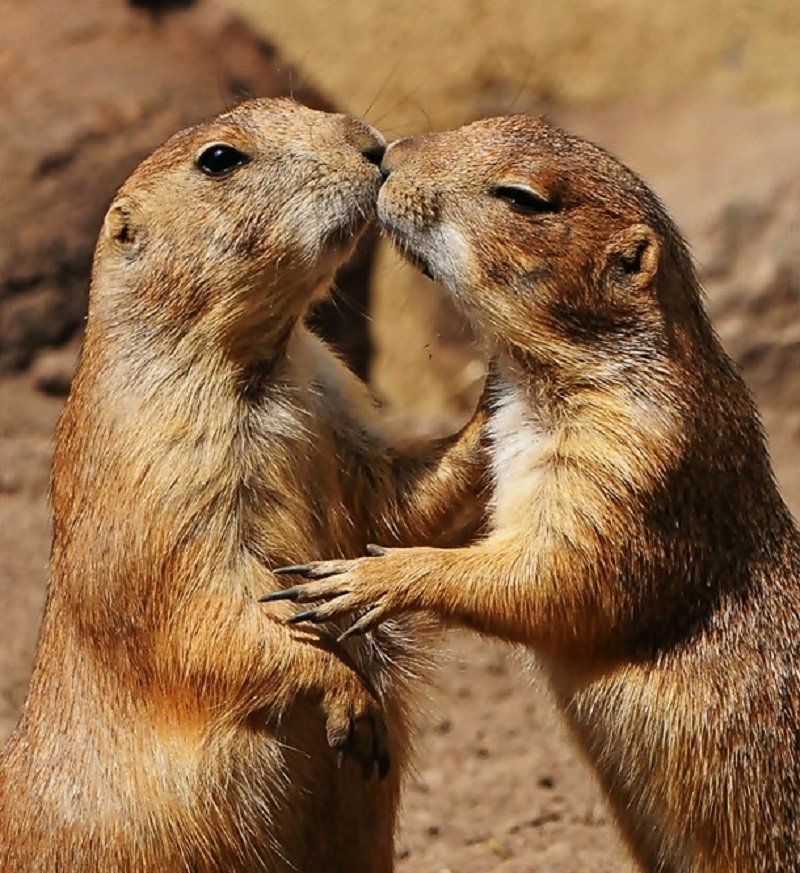It is commonly believed, that what distinguishes humans from other animals is not so much that we are largely hairless, but we have the faculty of language. This faculty is thought to have arisen more or less instantaneously from a genetic mutation. Language brought organization, to make a long story short, and organization put us on top of the food chain.
 A lot of research has been done in the past century which points another way. Animals may not be as dumb as we think they are. Numerous studies support the notion that animals do communicate sensibly, do have a sense of self and a capacity for abstract thought. They are quite entertainingly summarized in a book called “Chasing Dr. Dolittle”.
A lot of research has been done in the past century which points another way. Animals may not be as dumb as we think they are. Numerous studies support the notion that animals do communicate sensibly, do have a sense of self and a capacity for abstract thought. They are quite entertainingly summarized in a book called “Chasing Dr. Dolittle”.
Its author, Con Slobodchikoff, is a professor of referential communication at Northern Arizona University. He has studied animal communication all over the world and specializes in the communication of prairie dogs.

Prairie dogs once numbered in the millions across the grasslands of the Mid- and Southwest, but had the misfortune that they were considered pests for eating grass and liking the same flat surfaces for their burrows that developers like for their shopping malls. Now their numbers are down to about 2% of what they once were, a drop driven to a substantial degree by government-funded poisoning campaigns. There is a definite downside to this, by the way, because the burrows of prairie dogs – and all other burrowing animals – take the rain water underground, while shopping mall parking lots do not. It would be humanly impossible to replicate what burrowing animals do to bring the rain to the aquifer. But I digress.
Slobodchikoff found that prairie dog alarm calls not only distinguish between various predators, but can also give details about the appearance of the threat. In one experiment, calls were different for humans dressed in differently-colored T-shirts. In another experiment, the prairie dogs were confronted by an abstract shape, a black oval about the size of a coyote. Their alarm calls were similar to those for coyote, but not quite the same, translating as “somewhat like a coyote”, which is an abstraction.
“Chasing Dr. Dolittle” covers the whole gamut of linguistic studies of non-humans. Taking it altogether, it appears that no society, be it human, ant or prairiedog, can exist without sensible communication between its members. For example, how could a flock of starlings or a school of sardines, consisting of thousands of individuals, move as one the way they do, if they couldn’t convey something as basic as ‘I am right here”? How could a Mexican free-tailed bat find her own pup among the myriads of other pups in the cave, if it could not call out its name?
We think of language, Slobodchikoff argues, first and foremost as consisting of auditory symbols, words, strung together in an orderly manner. But information can be conveyed through any of the other senses. It can be visual, like a semaphore, or the changing coloration of an octopus, or the dance of a honey bee, or sign language. Facial expressions and gestures are in effect more telling than actual speech. It can be encoded in smells too, as ants do. That is why baking soda, which kills odors, confuses them and keeps them at bay.
Slobodchikoff points out that we tend to perceive the vocalizations of other animals as we hear them, like a chirp or a squeak or a bark. But human hearing is limited to a range of 100 to 20,000 Hz at best. These vocalizations might carry information on frequencies that are well outside our range. And what if animals process information on a different time scale? Consider, for instance, this chirp:
This is not a bird. Slowed down 30-odd times, it sounds like this:
So are these two curve-billed thrashers just emitting mindless chirps and whistles, or is their exchange meaningful, along the lines of:
“Did you hear about Ethel?”
“No – what?”
“Well..”
Whales, who also have big brains, change their songs all the time and share them as well, much like we do here at the station. Some songs become so popular that they are sung by whales around the world, going viral as it were. Here is a bit of whale song:
And this is the same recording, brought up by 4 octaves:
Clearly the hubby humpback calls for his wife ‘Emma’ and she yells somewhat irritably: “Now, WHAT?!”.
But seriously.
The notion that faculties like language are uniquely human has disconnected us from the rest of creation. Because of that disconnect, we have been able to exploit the earth without compunction. Now we have reached a point where that unrestrained exploitation is backfiring on us. It may be time to reconnect, to accept that we differ from our fellow creatures only by degree. As Slobodchikoff says in the closing paragraph of “Chasing Dr. Dolittle”: “For us the idea that other animals have language is a bridge back to the natural world”.
(Broadcast 4:56)
~o~o~o~o~o~o~
The Weekly Green is a KXCI mini-program on environmental topics from Southern Arizona and the rest of the universe.
The program airs on Monday 5:55 PM, Tuesday 4:55 AM, Wednesday 9:55 AM & 5:55 PM, Thursday 7:55 PM and Saturday 9:55 AM. First airing is usually at 10 am on Saturday.
Please email inquiries, suggestions and comments to [email protected] or post them on the Weekly Green Facebook page.

